|
Folks,
Ship Camouflage Instructions, Ships 2, 1942, is a manual for painting of ships from the middle during WW II.
We thank Ed Zajkowski for his generous loan of the original document used to create this online version.
Please report any problems with the Mail Feedback Form for correction.
Richard Pekelney
Webmaster
|
|
|

|
|
|
SHIP CAMOUFLAGE INSTRUCTIONS
UNITED STATES NAVY
SHIPS - 2
SECOND REVISION
Bureau of Ships
June 1942
A27914
|
1
|
|
PREFACE
The Bureau of Ships is issuing four publications on the subject of ship painting.
|
(1) Appendix 6 - An appendix to the General Specifications for Building Vessels of the U.S. Navy, covering the painting and cementing of new construction and conversions. (This forms a part of the contract specifications.)
(2) Ship Camouflage Instructions, U.S. Navy (SHIPS-2), containing CONFIDENTIAL information and supplementing other instructions.
(3) Formulas and leaflet specifications for materials used, including an appendix to the General Specifications for Inspection of Material (Appendix VIII) covering Paint and Paint Ingredients-Methods of Sampling and Testing).
(4) A Manual for Painting Ships in Service. (These are general instructions pertinent to painting procedure not covered by specifications.)
|
This publication is CONFIDENTIAL and shall be handled in accordance with the provisions of Article 76, U.S. Navy Regulations. It shall be given a wide circulation among commissioned personnel.
The publication shall be destroyed by burning when no longer required. No report of destruction need be submitted.
|
2
|
|
TABLE OF CONTENTS
|
Page |
| Introduction |
3 |
| Approximate Effectiveness of Camouflage Measures |
4 |
| General Directions for Camouflage Painting |
5 |
| Insignia for Identification |
5 |
| Camouflage Paints |
6 |
|
| CAMOUFLAGE PAINTING MEASURES |
| Measure 9 - Black System for Submarines |
7 |
|
| Measure 10 - Gray System for Submarines |
8 |
| PLATE I - Submarine painted with Gray System |
9 |
|
| Measure 13 - Haze Gray System |
10 |
| PLATE II - Destroyer Tender painted Haze Gray System |
11 |
|
| Measure 14 - Ocean Gray System |
12 |
| PLATE III - Destroyer DD 356 painted Ocean Gray System |
13 |
|
| Measure 16 - Thayer System |
14 |
| PLATE IV - Destroyer DD 380 Class - Thayer System |
16 |
| PLATE V - Destroyer DD 384 Class - Thayer System |
17 |
| PLATE VI -Four Stack Destroyer - Thayer System |
18 |
| PLATE VII - Patrol Boat PC 471 Class- Thayer System |
19 |
| PLATE VIII- 110 Foot Submarine Chaser-Thayer System |
20 |
| PLATE IX - Destroyer DD 421 Class - Thayer System |
21 |
| PLATE X - Destroyer DD 445 Class - Thayer System |
22 |
| PLATE XI - Transport AP 21 Class - Thayer System |
23 |
| PLATE XII - Cargo Ship AK 25 Class - Thayer System |
24 |
|
| Measure 21 - Navy Blue System |
25 |
| PLATE XIII- Cruiser CA 26 Class - Navy Blue System |
26 |
|
| Measure 22 - Graded System |
27 |
| PLATE XIV - Battleship BB 40 Class - Graded System |
28 |
| PLATE XV - Battleship BB 55 Class - Graded System |
29 |
| PLATE XVI - Cruiser CA 32 Class - Graded System |
30 |
| Cruiser CL 51 Class - Graded System |
30 |
| PLATE XVII- Aircraft Carrier CV 2 Class-Graded System |
31 |
|
| General Discussion |
32 |
|
3
|
|
INTRODUCTION
Definition of Ship Camouflage
Ship Camouflage may be defined as the means by which the visibility of a ship is reduced, or the means by which deception is caused in course or range estimation, or in class identification.
The most common method of attaining these ends is through some form of special painting, and this book is limited to camouflage by that means.
This is the Second Revision of SHIPS-2, and it supplants all previous issues in their entirety. Further revision should be expected and encouraged in a subject in which practice is far from becoming crystallized, and this book is therefore issued in loose leaf form. It is requested that pertinent comments be submitted and that instances of notably effective and ineffective camouflage be reported. Special forms for making camouflage reports have been printed and are issued with this book.
The Selection of a Suitable System
Ship camouflage measures have two general purposes:
(a) The Reduction of Visibility - Protective Coloration
(b) Course or Range Deception - Generally Pattern Systems
|
The systems included in this book belong in the first category. though Measure 16 contains some elements of deception.
No one type of camouflage can possibly give any protection under all situations. The method of ship painting must be adapted to the tactical situation which is involved, and a radical change in the tactics of either offense or defense should entail a re-examination of the suitability of the type of camouflage already in use. A method of ship painting which is intended to give protection during a period of greatest danger may at other times be of very high visibility.
Measures for reducing visibility have best chance of success at night, in gray weather or on hazy days when visibility is limited. Very light colored ships are best at night except in the glare of searchlight. Light colored ships are best against periscopic observation and dark ships are best against air observation. When light ships are clearly visible it is easy to judge target angle and make identification. Dark ships are much better in this respect.
The systems presented are to be placed in effect when ordered by competent authority. A summary of conditions under which the various methods will prove most effective is given on page 4, and a fuller explanation will be found under each camouflage measure.
|
4
|
|
APPROXIMATE EFFECTIVENESS OF CAMOUFLAGE MEASURES
FOR SURFACE SHIPS
|
Useful for Protection against Submarine attack, where aerial observation is a lesser factor.
(A) In northerly waters with much overcast weather and where attacks are prevalent at night.
Measure 16-Thayer System
Measure 13-Haze Gray System
|
(B) In Atlantic or Pacific Coastal waters where weather is generally sunny, visibility is high, and bright moonlight is common at night.
Measure 14-Ocean Gray System
|
|
Useful where greatest danger is from the air and high surface visibility must be accepted.
Measure 21-Navy Blue System
|
|
Useful for combatant ships operating in areas where greatest danger might be expected from gunnery action either from shore batteries or from enemy surface ships. Moderately high visibility to aerial observation at close ranges.
Measure 22-Graded System
|
|
5
|
|
GENERAL DIRECTIONS FOR CAMOUFLAGE PAINTING
The plates in this book are not all drawn to the same scale. In applying pattern, determine the location and size of paint areas by relation to structural points, or by proportionate measurement.
Unless otherwise indicated, all horizontal surfaces which are visible from the air shall be painted Deck Blue, 20-B. Exception: A stain of similar color has been provided for application to the flight decks of aircraft carriers. Sloping surfaces, such as the forward part of gun turrets, will be seen both from the air and from the surface, and the color of these areas shall be decided on the following basis:
|
(1) If the system is chosen for protection against aerial observation (Measure 21); paint sloping surfaces Deck Blue.
(2) If the system is intended for protection against surface or
submarine observation; paint the sloping areas with the same
color used for the adjacent vertical surfaces. Use Haze Gray
for Measures 13 and 22. Use Ocean Gray for Measure 14.
|
In measures 13, 14 and 22, all pole masts and their yards, slender upper works and attached small gear shall be painted Haze Gray 5-H.
Exposed brightwork shall be painted to harmonize with the exterior of the ship.
Glass windows shall be removed, rolled down or covered, unless conditions are such that light reflection from their surface is unlikely. Insofar as conditions permit, similar precautions shall be taken on airport lenses.
Canvas covers shall be colored to match adjacent ship paint.
Raised characters, such as ships' names and draft marks, shall be retained and painted the same color as the hull in that vicinity. Distinguishing numbers to designate the ship to friendly aircraft may be painted as heretofore on tops of turrets or as prescribed by the Commanders-in-Chief of the Fleets. Provision should be made to make them invisible except when identification is desired. On aircraft carriers deck markings shall be discontinuous and as narrow as will serve the purpose in order that they may not be used by enemy bombers to estimate the vessel's course.
INSIGNIA FOR IDENTIFICATION
Designating numbers or letters shall be painted on all vessels in the usual locations in white letters two feet high. They are to be without black shading, and on a line parallel with the base line, and when they are replacing larger sizes they are to be painted in the center of the space formerly designated for the numbers or letters. Wherever insignia is used, it shall be reduced in the same proportion as the numerals.
Exceptions:
|
(1) Wherever designating numbers or letters are now less than two feet high, the smaller size shall be retained for old and new construction.
(2) Motor Torpedo Boats Nos. 71-102 shall have black letters or numbers ten inches high.
(3) Letters shall be black for Thayer System.
|
|
6
|
|
CAMOUFLAGE PAINTS
Color
The Munsell Book of Color, as used by the Bureau of Standards, the Naval Research Laboratory, and the Bureau of Ships, has been found to be the most practical means for specifying and matching colors for camouflage. The letters of the Munsell notation refer to the hue, the first number refers to the reflection factor, and the second number refers to the degree of purity of the hue, that is, the absence of gray.
Reflection Factor
The per cent of incident light reflected from a surface is an accurate method of describing the lightness or darkness of that surface. It naturally follows that a light paint has a larger per cent of reflection than a dark paint. This per cent may be called the reflection factor. The reflection factor is independent of the color (hue) of the surface. It may specify a neutral gray which has no hue.
Gloss
Gloss is the power of a surface to reflect light specularly, which means like a mirror, and a surface which is not glossy is said to be mat. A convenient method of measuring gloss is based on the ratio of the amount of light reflected at an angle of 60 degrees from the surface in question to the amount reflected at the same angle from polished black glass. This scale has been used in the accompanying table. High gloss is very objectionable in camouflage paint.
Mixing
The camouflage systems established to date require the use of white and five colors. Samples of the colors, enclosed in an envelope, accompany this book. Deck Blue paint, for all surface vessels except carriers, and Aircraft Carrier Flight Deck Stain, are supplied ready-mixed from the Navy Yards. Navy Blue, Ocean Gray and Haze Gray paints are made by adding to 5 gallons of white untinted base (5-Ua) the stated number of pints of dark blue-black tinting material (5-TMa) listed in the table below. Thayer Blue is made by mixing 5 gallons of 5-Ua with a special tinting material (5-BTM) in the proportions given below:
|
FORMULA |
MUNSELL |
REFLECTION
FACTOR |
GLOSS |
NUMBER OF PINTS
IN MIXTURE |
| NAVY BLUE |
5-N |
PB 3.4/3 |
9% |
4 |
15 pints of 5-TMa |
| OCEAN GRAY |
5-O |
PB 5/3 |
18% |
3 |
5 pints of 5-TMa |
| HAZE GRAY |
5-H |
PB 6/2 |
28% |
3 |
2 pints of 5-TMa |
| DECK BLUE |
20-B |
PB 3/4 |
7% |
11 |
issued ready-mixed |
| THAYER BLUE |
5-B |
PB 8/2 |
50% |
3 |
1 pint of 5-BTM |
|
7
|
|
CAMOUFLAGE PAINTING MEASURES
MEASURE 9 - BLACK SYSTEM FOR SUBMARINES
Effectiveness
Lowest visibility when submerged. When on surface low visibility to aerial observers in all types of weather, except up-sun in bright weather. When on surface high visibility to surface observers in all types of weather.
Method of Application
Black-Formula 82 Paint entire submarine above the water line black. The painting shall be carried over all parts which are visible from the air including the numbers, capstan, running light boards and bridge rails.
The Radio insulators shall be dark. There shall be no boot-topping. The underbody shall be painted with current issues of black antifouling paints.
|
8
|
|
MEASURE 10 - GRAY SYSTEM FOR SUBMARINES
Effectiveness
Low visibility for submarines when on the surface both to surface observation and low angle aerial observation.
High visibility to high angle aerial observation when the submarine is on the surface or submerged in clear water,.
Will not offer the same protection as the black system to submerged submarines operating in areas where aerial observation is an important factor, but will be lower visibility against either sea or sky when observed by surface ships.
Method of Application
Paint entire submarine above the water line Ocean Gray, 5-0. The painting shall be carried over all parts which are visible from the air including the numbers, capstan, running light boards and bridge rails.
The Radio insulators shall be dark. There shall be no boot-topping. The underbody shall be painted with current issues of black antifouling paints.
|
9
|

SUBMARINE Pike Class
Measure 10 - Gray System for Submarines
PLATE I
|
10
|
|
MEASURE 13 - HAZE GRAY SYSTEM
Effectiveness
Low visibility to surface observers in hazy or foggy weather especially when it is accompanied with periods of weak sunlight.
High visibility in bright weather when seen against the water.
Useful in submarine infested areas, where periscopic observers will see a vessel entirely against a sky background.
High visibility under searchlight, and down-moon at close ranges. Very low visibility on moonless nights and at twilight. Method of Application
Haze Gray 5-H All the vertical surfaces of the ship above the
waterline.
Deck Blue 20-B Deck surfaces and other horizontal surfaces, which are visible to aerial observers. Under sides of overhanging horizontal surfaces may be painted with white (5-U) to lighter) shadows.
|
11
|
|

DESTROYER TENDER AD 3 Class
Measure 13 - Haze Gray System
PLATE II
|
12
|
|
MEASURE 14 - OCEAN GRAY SYSTEM
Effectiveness
Low visibility to surface observers in bright sunny weather and down-moon on moonlit nights.
High visibility in bright weather to aerial observers at close ranges, but not necessarily so at distant ranges. Its maximum utility would be against surface observation in areas where sunny weather is common.
Moderately high visibility in overcast weather or on moonless nights. Inferior to Measure 13 under such circumstances, but superior to it in areas where bright sunlight predominates.
Method of Application
Ocean Gray 5-O. All vertical surfaces except slender pole masts,
their yards and slender upper works.
Haze Gray 5-H. Slender pole masts, yards and slender upper
works.
Deck Blue 20-B. All decks and other horizontal surfaces which
are visible to aerial observers. Under sides of overhanging horizontal surfaces may be painted with white (5-U) to lighten shadows.
|
13
|

DESTROYER DD 356 Class
Measure 14 -- Ocean Gray System
PLATE III
|
14
|
|
MEASURE 16 - THAYER SYSTEM
Effectiveness
Lowest visibility to surface observers on moonless nights and in overcast weather.
High visibility down-sun or down-moon in bright clear weather, but reduced visibility up-sun and up-moon in all weathers.
Especially well adapted for winter use in Northern areas where nights are long and days frequently overcast. It would prove useful against submarines in any area where attacks occur mostly at night, but in bright weather it would be very visible to surface raiders, or to high-flying aircraft, when observed down-sun.
Some deception as to target angle has been reported for both day and night operations.
Special Characteristics
The special feature of this system is its changeable character. At low levels of illumination a blue paint will appear relatively lighter and a red paint will appear relatively darker than these two paints appear in daylight. This visual change, known as the Purkinje effect, is utilized in the Thayer System. The pure light blue which is employed has been selected because it will appear practically like white paint at low levels of illumination. The ship will therefore appear like a white ship on moonless nights or during twilight when white or very light ships are best for reduced visibility. During daylight hours or under bright moonlight the pattern will be apparent and will produce some deception in the estimation of the target angle. A darker blue would produce more deception but can not be used because it will not appear white at night. The purity of the color is an important factor in the Purkinje effect, and even a slight admixture of black in the paint will reduce its effectiveness at night.
Colors Employed: Thayer Blue and White
Type Plans
Typical deception patterns of the Thayer System are shown on PLATES IV to XII inclusive. Patterns are shown for both port and starboard sides, and should be so used in order to get the best end-on effects. Though shown for certain specific classes of ships, the designs can and should be adapted to other types and classes.
|
15
|
|
THAYER SYSTEM (CONTINUED)
The application of similar patterns to both large and small vessels of similar profiles may cause uncertainty as to the identity of the class of vessel.
A distinctive individual design for each vessel might serve to identify the ship.
Method of Application
Size of Pattern
In adapting plans to vessels for which they were not specifically designed the size of pattern should be considered. As currently practised in the Fleet, the areas used in pattern camouflage have often been too small to be effective. Small areas will, beyond a short range, appear as a uniform color, and will have no superiority over such a color.
Countershading
The aim of the Thayer System is to create a ship which will appear like a white ship at night, and the "contained shadow", which is one of the stumbling blocks to all successful camouflage, is far more noticeable on light ships than on dark ships. The situation can be improved by a liberal application of white paint to all areas which are commonly in shadow. For example the shadow which is usually noticed below and around a small boat can often be lightened by the use of white paint. The application of white paint to the under side of projecting decks will, through reflection, lighten the vertical surfaces on which they cast shadows.
A pronounced shadow is frequently seen on the bow of some types of vessels due to the bow flare, and a large area of white applied to the bow, and intended to compensate for this shadow, is a rather common feature of camouflage design. The importance of countershading at this particular point may easily be exaggerated. The Thayer System is designed for use in northern latitudes, where due to the low altitude of the sun, the bow flare will present no problem at all in winter, and will only be noticeable for a few hours in the middle of the day in midsummer. If a better deception can be secured by the use of blue pattern at this point on the bow, its use would be amply justified.
Countershading with white paint must be left to some extent to individual judgment. The type plans show only the larger areas of blue pattern, and it may often happen that areas will be found within them which will be improved by countershading with white.
|
16
|
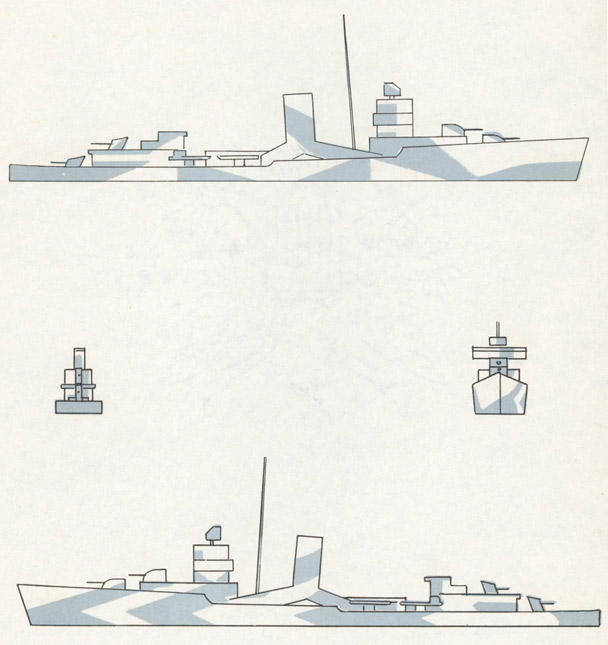
DESTROYER DD 380 Class
Measure 16 - Thayer System
PLATE IV
|
17
|
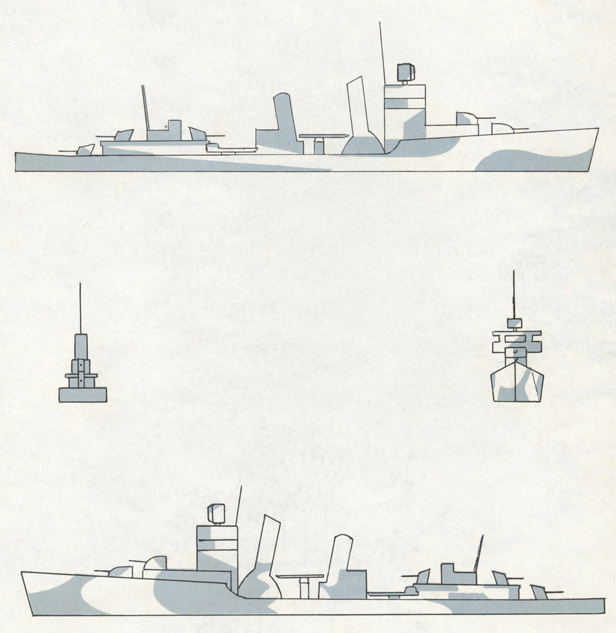
DESTROYER DD 384 Class
Measure 16 Thayer System
PLATE V
|
18
|
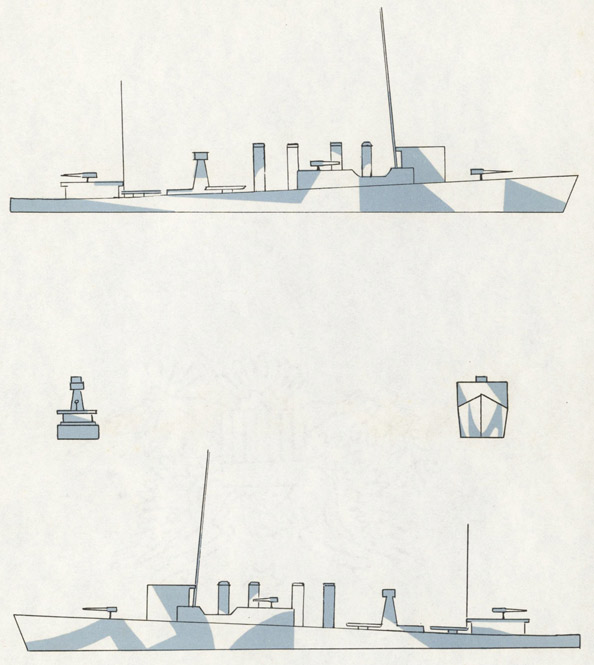
Four Stack Destroyer
(Adaptable to Three Stack Destroyer)
Measure 16 - Thayer System
PLATE VI
|
19
|
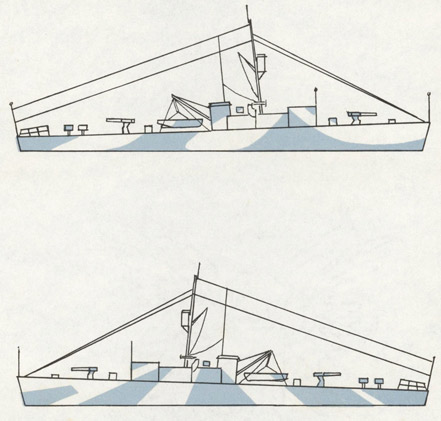
PATROL BOAT PC 471 Class
Measure 16 - Thayer System
PLATE VII
|
20
|
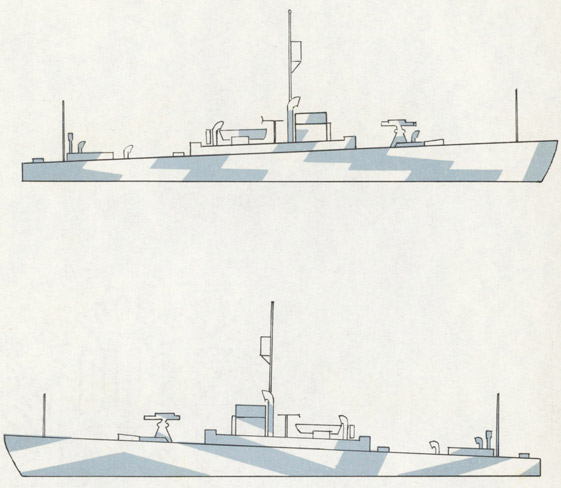
110 FOOT SUBMARINE CHASER
Measure 16 - Thayer System
PLATE VIII
|
21
|
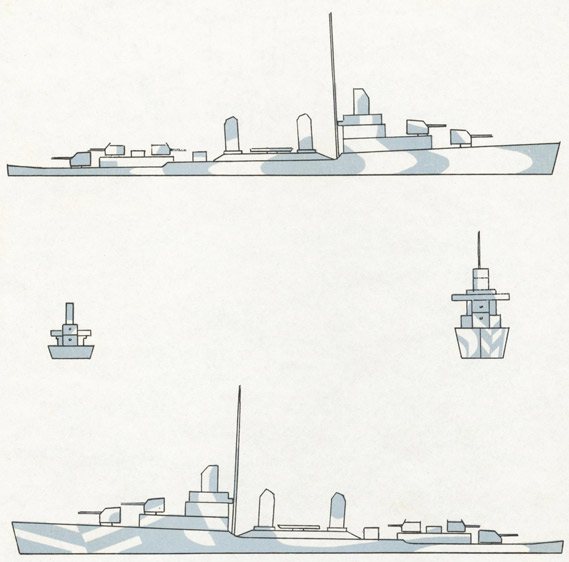
DESTROYER DD 421 Class
Measure 16 - Thayer System
PLATE IX
|
22
|

DESTROYER DD 445 Class
Measure 16 - Thayer System
PLATE X
|
23
|

TRANSPORT AP 21 Class
Measure 16 - Thayer System
PLATE XI
|
24
|

CARGO SHIP AK 25 Class
Measure 16 - Thayer System
PLATE XII
|
25
|
|
MEASURE 21 NAVY BLUE SYSTEM
Effectiveness
Lowest visibility to aerial observers day and night in all types of weather. Low visibility under searchlight. High visibility to all surface observers in all types of weather. Considerable course deception to surface observers in all types of weather.
Method of Application
Navy Blue 5-N. All vertical surfaces without exception.
Deck Blue 20-B. All deck and horizontal surfaces.
|
26
|

CRUISER CA 26 Class
Measure 21 - Navy Blue System
PLATE XIII
|
27
|
|
MEASURE 22 - GRADED SYSTEM
Effectiveness
This measure is intended for use on combatant ships in areas where bright weather with fair visibility predominates, and high angle aerial observation is unlikely, and there is a likelihood of a gunnery engagement. There will be some reduction of visibility when viewed from low-flying planes, and from higher altitudes at extended ranges.
Method of Application
Navy Blue 5-N To be applied to the hull to the height of the main deck edge at its lowest point, as shown on Plates XIV to XVII. The upper edge of this Navy Blue area should be horizontal.
Haze Gray 5-H All remaining vertical surfaces and all masts and small gear.
Deck Blue 20-B All decks and horizontal surfaces visible from aerial observation. Under sides of overhanging horizontal surfaces may be painted white (5-U) to lighten shadows.
|
28
|

BATTLESHIP BB 40 CIass
Measure 22 - Graded System
PLATE XIV
|
29
|

|
|
BATTLESHIP BB 55 Class
Measure 22 - Graded System
PLATE XV
|
30
|

CRUISER CA 32 Class

CRUISER CL 51 Class
Measure 22 - Graded System
PLATE XVI
|
31
|

|
|
Measure 22 - Graded System
PLATE XVII
|
32
|
|
DISCUSSION
Camouflage opinion divides broadly into two schools of thought with rather divergent aims.
(a) Protective Coloration (formerly called Low Visibility)
(b) Deception Systems (involving the use of Pattern)
|
Protective Coloration
The first American camouflage systems approved by the Bureau of War Risk Insurance during the first World War all used some form of pattern, but it was used in the expectation that it would aid in reducing visibility at a distance. The desirability of an invisible ship was conceded and the split in policy resulted from the fact that complete concealment, either with pattern or with uniform color, has proved so difficult of attainment.
The first American camouflaged ship to cross the Atlantic was the S.S. ST. PAUL, painted early in the winter of 1917 utilizing "counter-shading" in an effort to reduce the visibility of shadows. This method was based upon the research of Abbott H. Thayer, a celebrated American painter of a past generation, who was a pioneer student of the protective coloration of birds and animals. He was the earliest advocate of a white ship, and unsuccessfully labored to secure its adoption both in the U. S. Navy and by the British Admiralty. When, a quarter of a century later a British artist and naval officer, Lt. Peter Scott, R.N.V.R., again proposed the white or very light ship its great value at night or in overcast weather was beginning to be recognized, and it is now coming into favor for certain areas. Measure 16, the American equivalent of the British Western Approaches system, has been named the Thayer System.
Limitations in the Use of Protective Coloration
In Protective Coloration in Nature there is always some "cover" or fixed background which may be matched. The background of a ship at sea is constantly changing and the problem is very much more complex. An inherent difficulty with camouflage for reduced visibility lies in the fact that the color or shade which is best for one time will inevitably be the worst possible color at another time. Some persons have laboriously attempted to average all the possible backgrounds against which a ship may be seen throughout the day - throughout the year. Such an average color is merely a "service paint". It is not camouflage, because it is not aimed at the period of greatest danger. To have a reasonable chance of success a more limited objective must be selected. The requirements of the situation are:
|
33
|
|
"Pick the particular circumstances under which a successful camouflage would be of the greatest tactical value. Use the method of camouflage best suited to accomplish the maximum reduction of visibility in these circumstances, accepting what increases in visibility may ensue in other conditions." |
Generally speaking light ships are best against surface observation and dark ships against observation from the air, but it is necessary to make closer distinctions than we have been in the habit of doing. The very dark ship will be best at the bombing angle, but at very long ranges or to low-flying planes a lighter ship may be better. For night or overcast weather the pure white ship often will not be quite white enough for invisibility, but in bright sunshine it will be extremely visible when seen down-sun. However the advent of very light ships is making it necessary for us to revise the generally accepted dictum that no paint is effective when the ship is seen up-sun. White or light ships often prove quite successful when seen up-sun, which in some measure compensates for their very bad performance when seen down-sun on a bright day.
It is necessary to select the color best suited to the period of greatest danger, irrespective of high visibility at less critical times.
In reaching conclusions on systems of camouflage aimed at surface attack, it is desirable to avoid judgments based on observations of vessels at close ranges. Except at night or in a thick fog, no one expects a vessel to disappear at close range, and in clear weather the color which is deemed satisfactory at that range is almost certain to be too dark when the vessel begins to reach those ranges where invisibility might be reasonably expected. Light ships behave better than dark ships at long ranges, and pure white even in bright sunshine will be better than medium gray when applied to small areas such as masts. In tests made in 1919 on the U.S.S. OHIO, range-finder readings ceased on the masts (painted pure white) several thousand yards before they stopped on the next ship in column where the masts were painted the battleship gray in use at that period.
There is some evidence to show that a vessel correctly painted to disappear against a distant horizon sky on a bright day must inevitably appear very conspicuous when seen close at hand. Invisibility occurs when a ship presents no contrast with its background, and the customary approach, which has been to match the paint to the sky, can never completely succeed because it ignores the shaded areas of the ship which we now call contained shadow.
|
34
|
|
It is obvious that the invisible ship must be the sum of two reflectances--that of the contained shadow and that of the camouflage paint. Since the shadow is almost invariably much darker than the sky, it is necessary to make the paint lighter than the sky in order that the visual mixture of the two, which occurs at a distance, shall exactly equal the sky background. Large areas of light paint on the superstructure, appearing as strong contrast close at hand, may well prove to be the only way by which the shadow can be obliterated.
The situation is quite different when the vessel is seen from the air against the water. In this case the shadows are not very different from the color of the water, and dark colors such as Navy Blue and Deck Blue will serve to conceal the vessel very effectively.
The menace of air attack caused a general revision of ideas about camouflage, and complicated the situation for protective coloration camouflage even more than it did for deception camouflage. The very dark ship proved best against aerial observation, and the very light ship was best from the surface viewpoint. A compromise color was not very good for either situation. This dilemma has made a deliberate choice necessary, a choice dictated by the chief source of danger in any given area. The belief that one average color could serve as a universal panacea was always untenable, but the advent of aerial attack made it obvious.
An average sky, spoken of as the "weather coefficient", may be a matter of interest, but it is a matter of no real importance, unless it can be shown that such an average sky matches the typical sky of the period of greatest danger. The methods used in seeking to attain reduced visibility remain much the same as they have always been, but there is a new understanding of their proper use, which should insure more effective results. Our use of Measure 21 in Pacific areas, and the British use of their Western Approaches System in Northern waters, are good examples of a tactical use of paint, whereby high visibility under certain conditions is accepted as an essential concomitant of reduced visibility for more critical periods.
|
|
|